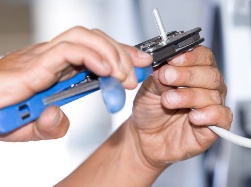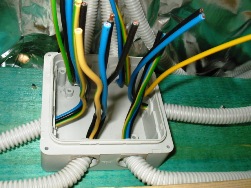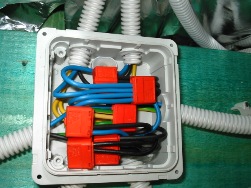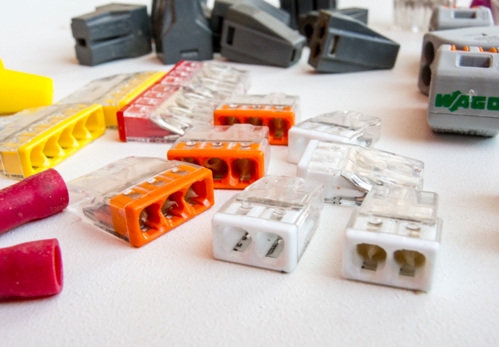Categories: Featured Articles » Electrician at home
Number of views: 222978
Comments on the article: 15
Methods of connection, termination and branching of wires and cable cores. Top articles
 Contact connections are a very important element of electrical work, because the reliability of any electrical installation is largely determined by the quality of the electrical contact.
Contact connections are a very important element of electrical work, because the reliability of any electrical installation is largely determined by the quality of the electrical contact.
All contact joints are subject to certain technical requirements, including electrical parameters, design, good resistance to mechanical factors, reliability and safety. This collection contains the best articles on the site Electrician Infoin which the main ways to create quality joints and branches wires and cable cores in electrical installations.
At the point of contact of the two conductors arises contact resistance, the value of which depends on a large number of factors: physical properties of the materials in contact, their condition, compressive strength at the point of contact, heating temperature, etc.
About what is the transition resistance, what factors depend on its magnitude, how to get a stable transition contact resistance during operation, read in this article: What is transition contact resistance and how to deal with it
Especially unfavorable from the point of view of the reliability of electrical contact is aluminum surface. After a few seconds of exposure to air, the pre-cleaned aluminum surface is covered with a thin oxide film, solid and refractory, which has high electrical resistance. The melting point of aluminum is 565 - 578 aboutC, and its oxide film is about 2000 aboutFROM.
Another feature of aluminum is its low yield strength. The tightened contact joint of aluminum surfaces weakens over time. This greatly complicates the obtaining of high reliability contact when using aluminum conductors. Read more about this here: Why can not the aluminum cable be used in wiring?
Unlike aluminum copper has better conductivity, oxidizes slowly and has satisfactory mechanical characteristics. The oxide film on copper is easily removed and slightly affects the quality of the electrical connection.
When directly connected to copper, aluminum forms a galvanic pair, being a negative electrode in it. An electrochemical process occurs at the point of contact, as a result of which aluminum is destroyed.
To connect copper and aluminum wires and cable conductors, you need to use special terminal and bolt connections, which are described in this article - How to connect copper and aluminum wires.
 When creating a contact connection, special attention is always paid preparation of wires and cables: remove insulation from cores with a specialized tool or lineman's knife, with an emery cloth, acetone or white sprit, they clean the bare parts of the veins. The length of the cutting should take into account the particular method of connecting, branching or terminating the conductors of wires and cables.
When creating a contact connection, special attention is always paid preparation of wires and cables: remove insulation from cores with a specialized tool or lineman's knife, with an emery cloth, acetone or white sprit, they clean the bare parts of the veins. The length of the cutting should take into account the particular method of connecting, branching or terminating the conductors of wires and cables.
How to quickly remove insulation from a cable or wire
There is a wide variety installation methods for electrical contact. The highest quality contact connection will always be one that provides the lowest transition contact resistance for as long as possible.
The main methods for making contact joints are welding, soldering, crimping, bolted and terminal connections. Each of these methods has its advantages and disadvantages.
Wiring methods: from twists to soldering
Prior to the introduction into the electrical installation practice of crimping and welding, the method of connecting, branching and terminating copper cores soldering was the main one. Widely used methods of twisting small cross-section veins with subsequent soldering them with soft tin solders. Now this method is rarely used due to its high complexity.
The process of soldering wires and cable conductors consists in coating the heated ends of the connected conductors with molten tin-lead solder. Rosin, stearin or soldering ointment (solder fat).
For soldering copper wires of small cross sections, solder tubes filled with rosin or a solution of rosin in alcohol, which is applied to the junction before soldering, are used. The connection must be mechanically strong. The soldering should be smooth, without pores, dirt, sag, sharp bulges of solder, foreign inclusions - What is soldering? Soldering Safety, Solders and soldering fluxes, How to learn to solder.
After soldering, 2-3 layers of adhesive insulating tape are applied to the contact joint with overlapping of each turn. It is very desirable to cover this place with moisture-resistant varnish on top. Instead of insulating tape, an insulated cap can be put on the soldered contact joint.
Soldering is also used when terminating copper stranded cores in a ring. This is the best way to terminate copper stranded conductors with a cross section of up to 2.5 mm2. The soldered ring should be evenly coated with solder. The midwire wires must fully enter the monolithic part of the ring, and its diameter should correspond to the diameter of the screw clamp.
To create a high-quality soldered contact connection, the conductors of wires (cables) must be twisted correctly. The quality of the soldered contact very much depends on the correct twisting. See how to make a good twist here:
How to make a good twist of wires?
How to do splicing and branching wires using twisting
One of the oldest ways to create a contact is the use of bolt and screw connections. They relate to collapsible contacts. The stabilization of the transition resistance in them is carried out by tightening the screw or bolt.
It is recommended that no more than two conductors be connected to each screw or bolt. When connecting multi-wire cores to such terminals, special tips must be used or the ends of the wires soldered.
 Recently, a very popular way of connecting wires and cable conductors is use of self-clamping terminal blockstype Wago. There are other manufacturers of this type of electrical products - terminal blocks REXANT, TRIDONIC, Klemsan, SMK, etc.
Recently, a very popular way of connecting wires and cable conductors is use of self-clamping terminal blockstype Wago. There are other manufacturers of this type of electrical products - terminal blocks REXANT, TRIDONIC, Klemsan, SMK, etc.
Wago terminal blocks in home wiring
How are the WAGO terminal blocks arranged?
Which wire connection is more reliable - Wago clamps or twisting? Real test history - the test results of these two connections at different operating modes - nominal, maximum operation and emergency mode - a strong current overload of the wire.
One of the most popular connecting materials among electricians is connecting self-insulating clamps (PPE):
PPE caps insulating for twisting wires
Welding gives a monolithic and reliable contact, so it is widely used in electrical work:
Why welding is always better than other wire connection methods
Welding wire connection - The article describes welding machines for welding wires (including home-made structures) and welding technology.
Crimping is one of the most reliable wire connection methods. Crimping the connection of conductive conductors is performed using sleeves by continuous compression or local indentation with special tools (press tongs), into which interchangeable dies and punches are inserted. In this case, indentation (or compression) of the sleeve wall into the cable core occurs with the core wires being sealed and a reliable electrical contact is formed.
Read how to do this in this article: Connection of wires by crimping.
Using crimping pliers, they also terminate the conductors of wires and cables. To do this, use special tips for crimping: Methods for terminating cable and wire cores.
Very often, electricians have to connect the electrical installation to an existing line, passing by in relative proximity. In other words, it is necessary create branch wire. This article discusses how to create branches using special branch clamps, terminal blocks and piercing clamps - Wiring Methods
In wiring practice, branching clamps, such as "nuts", are most popular. Read how to use them correctly here - How to branch using branch clamps
When creating connections, terminations and branches of wires and cables, do not forget to follow the safety rules, this is especially important when using special tools and equipment!
Waiting for your comments!

See also at bgv.electricianexp.com
:
